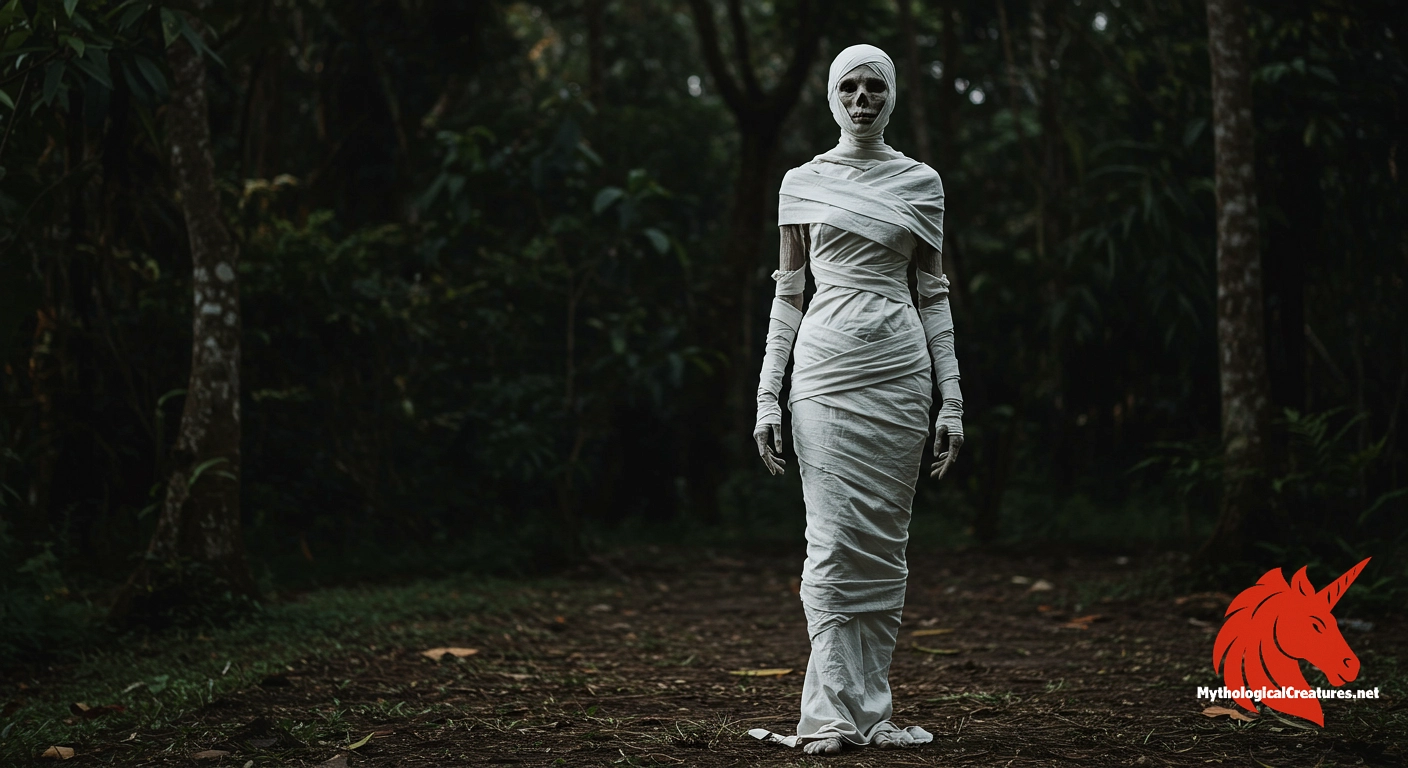Pocong: Pocong is a ghost from Indonesian and Malay folklore, appearing as a person wrapped in a white funeral shroud.

Pocong
Pocong - Represents the consequences of improper funeral rites and the unsettled state of the dead.
Origins & First Encounters
The figure of the Pocong occupies a distinctive niche in Southeast Asian supernatural lore, captivating audiences with its eerie embodiment of unfulfilled funeral rites. Emerging from a fusion of indigenous and Islamic cultural practices, it stands as a somber reminder of the importance of ritual in transitioning from life to death. Its roots lie in the intricate traditions of Islamic burial ceremonies, where the dead are wrapped in a white shroud known as kain kafan. A failure to release the knots binding this shroud is believed to trap the soul in a state of limbo, giving rise to the Pocong. Over time, the story has transcended oral traditions to become a well-known element of modern ghost narratives in both Indonesia and Malaysia. The ghost's legend reflects broader concerns about proper burial practices and the consequences of neglecting sacred customs. Stories of the Pocong have been handed down through generations, evolving with each telling while maintaining a core message about the spiritual transitions associated with death. Its enduring presence in local folklore illustrates the deep cultural significance attached to the rituals surrounding departure from the earthly realm.
Source Texts & Tale Variants
The narrative of the Pocong is primarily preserved through rich oral traditions, where vivid tales have been recounted in community gatherings and local storytelling sessions for many years. Although early written records are sparse, the lore has been disseminated through various forms of local literature and modern media, keeping its mythos alive. Diverse storytellers paint a picture of a spirit whose existence is inextricably linked to the specific practices of funerary rites. Variants of the legend have evolved in different communities, with some emphasising the ghost’s potential for malevolence while others imbue it with an almost sympathetic supernatural presence. In rural settings, anecdotes and local anecdotes often highlight the Pocong’s mysterious appearance during the night, contributing to its reputation as a harbinger of unresolved transitions. Contemporary publications and horror anthologies have adopted and adapted these age-old narratives, weaving them into modern cultural dialogues. The multiplicity of versions underscores a dynamic tradition that accommodates varying societal values and local beliefs. In this way, the primary sources and story variants about the Pocong reflect a living tradition that continues to evolve while preserving its link to historical customs.
Form & Powers
The Pocong is visually distinguished by its unmistakable shrouded form, which clings to the body like a second skin and obscures much of its human features. The spectral figure appears encased entirely in white fabric, reminiscent of the traditional Islamic burial shroud that wraps the deceased. Its outline remains distinctly human, yet the tight bindings distort natural proportions to create an unsettling visual effect. In many depictions, the face is partly concealed, with only a pair of hollow, vacant eyes occasionally peeking through the fabric, enhancing its ghostly appeal. The knots that secure the shroud are often portrayed as both intricate and foreboding, symbolising the unresolved state of the soul. The overall aesthetic is one of eerie suspension, as the corpse seems caught between the realms of life and death, its movement slow and deliberate. Variations in depictions can include differences in how tightly the shroud is wrapped, resulting in slight alterations to its silhouette. This amalgamation of human form and shrouded mystery creates a powerful icon of cultural anxiety regarding the rites of passage from life to death.
Regional Faces
Across Indonesia and Malaysia, the figure of the Pocong takes on nuanced characteristics that reflect localized interpretations of death and the supernatural. In the heartland of Java, the ghost is often portrayed with a rigid emphasis on the sanctity of the Islamic funeral ritual, highlighting the dire consequences of neglecting ceremonial norms. In contrast, communities in more remote regions may paint the Pocong as a figure of both dread and tragic sympathy, underlining regional superstitions. Malaysian renditions, where it is sometimes referred to as Hantu Bungkus, incorporate distinct cultural elements that adapt the tale to local sensibilities. The manner in which the shroud is depicted can vary, with some areas suggesting a looser binding that gives the ghost an almost animated quality. Rural narratives often include a mix of humour and horror, reflecting an acceptance of the spectral as an everyday part of life. Urban interpretations, meanwhile, tend to blend traditional imagery with modern urban legends, resulting in a multifaceted portrayal. These regional variations underscore the adaptability of the myth, mirroring the diverse cultural landscapes from which the legend originates.
Cultural Parallels
The tale of the Pocong shares many thematic elements with ghostly figures found across the globe, forming intriguing cultural parallels with other traditions. Its portrayal as an entity caught between the realms of life and death resonates with East Asian yūrei, whose stories similarly revolve around disrupted transitions. Like the European White Lady, the Pocong’s pallid, shrouded visage invokes a universal sense of melancholy and unresolved sorrow. The motif of a bound or encapsulated spirit finds echoes in myths of mummified revenants from ancient civilizations, where physical restraint symbolises eternal unrest. Both the Pocong and these comparably tragic figures highlight the significance of proper ritualistic honour in ensuring a peaceful passage to the afterlife. This comparison serves to illustrate a broader human preoccupation with the consequences of disrupted rites and the lingering bonds of the corporeal form. The shared narrative of unfinished business bridges disparate cultures, emphasising a collective concern for the sacred order of mortality. In this light, the Pocong not only occupies a distinct cultural space but also participates in a universal dialogue about life, death, and the rituals that connect them.
Legacy & Modern Evolution
Over time, the image of the Pocong has undergone a remarkable evolution, emerging from its humble folktale origins to become a prominent figure in modern popular culture. Initially confined to whispered stories in villages and traditional oral recitations, the ghost now finds a place in films, television programmes, and literary works that explore themes of the supernatural. Contemporary portrayals often blend elements of humour with horror, transforming the Pocong into a multi-dimensional character that can both frighten and charm. The digital age has seen this spectral figure reimagined through various artistic mediums, reinforcing its role as a cultural icon of Indonesia and Malaysia. Urban legends and horror festivals celebrate the story, reflecting an ongoing fascination that transcends its original ritualistic roots. Modern reinterpretations sometimes serve as subtle social commentaries on issues such as modernity versus tradition, the nature of belief, and the rituals that mark life’s transitions. Despite these shifts, the ghost continues to symbolise the dire importance of adhering to cultural norms and ritualistic practices. Today, the legacy of the Pocong endures as a blend of age-old mystique and contemporary relevance, inviting renewed exploration into themes of mortality and the supernatural.
Interesting Fact
The Pocong's enduring legacy in Indonesian horror cinema highlights its role as both a cautionary tale and a cultural icon of the supernatural.
Quick Creature Info
Origin:
Associations:
Our Mythic Legendary Rating:

Also Sometimes Known As:
Habitat:
Supernatural Powers:
Physical Attributes:
Abilities:
Behavior:
Lore:
Related Creatures, Tales or Lore
- KKuntilanak
- PPontianak
- SSundel Bolong
References
Discover Another Mythical Legend You May Not Have Heard Of?
Uncover the mysteries of ancient folklore and expand your knowledge of legendary beings from cultures around the world.
Dare to Meet the Crius....
Mythical Disclaimer: The images and data on this site are derived from various historical and literary sources, but we have found that many myths often have multiple versions and interpretations across references, sometimes contradictory. As a result, these creature depictions are artistic interpretations—imaginative blends of folklore, legend, and a dash of AI guesswork. Because creature descriptions vary widely, our illustrations and accompanying information represent our best effort to honor mythology while bridging creative gaps. Enjoy these interpretations—just remember, we've done our best to respect the stories and validate available data, but in the realm of mythology, details often shift, imagination leads the way, and nothing is ever set in stone!
Curated by the Mythological Creatures Team (rev. May 2025)
